Quick search
CTRL+K
Quick search
CTRL+K

Antwerp is a Flemish metropolis that has become rich after centuries of large-scale trade with the whole world, and it can still be seen today with the city’s activity and busy port. With Antwerp’s strategically good location, it has developed into one of Europe’s largest port citys.
The city center is beautiful and characterized by the wealth that through time made the city’s commercial and religious buildings possible to build. Many areas have richly furnished houses with Grote Markt as the central square. When in town, it is just about exploring central Antwerp and enjoy the fine architecture and atmosphere here.
Churches and buildings have been built over time in varying architectural styles in the city. The highlights of Antwerp’s many large churches are for many the works of art created by not least Peter Paul Rubens. From the old beautiful architecture to today’s modern architecture, the city is visibly evolving. This can be seen in some of the areas down to the river Schelde, and there are also recently developed areas along the old harbor basins closest to the center.
The river has always been Antwerp’s economic lifeline with the goods and trade on the seas to the world. Diamonds are just one of the many goods that Antwerp has been associated with over the years and which have helped to create the wealth that has shaped the city till today.
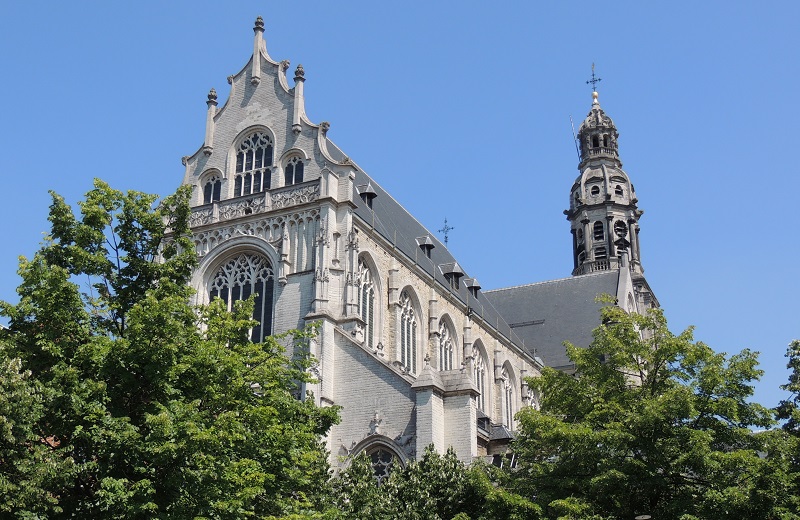
This church was originally part of a large Dominican monastery. The complex was inaugurated in 1571, but changes have taken place since then. After a fire in 1679, the church tower was rebuilt in the baroque style of the time. The church’s works of art have been stolen and returned, and during the rebellion of 1830 the building was heavily damaged.
The church has now been restored and stands as a stunningly beautiful sight. Carpentry, countless paintings and hundreds of sculptures are just some of the details you will encounter. Among the artists are many of Antwerp’s celebrities such as Rubens and van Dyck.
The Grote Markt is the heart of Antwerp’s old town, and the name also means The Great Square. Most interesting is the town hall on the west side of the square and the many Flemish Renaissance buildings on the north side; they are erected by the different lichens of the city.
In the middle of the square stands the Brabo Fountain, executed by the sculptor Jef Lambeaux in 1887. The fountain honors the Roman soldier Silvius Brabo, who, according to legend, overcame the giant Druoon Antigoon, who cut off the hands of the people who would not pay him tolls in order to pass the bridge over the river Scheldt which he guarded. Brabo cut off the giant’s own hand and threw it into the river.
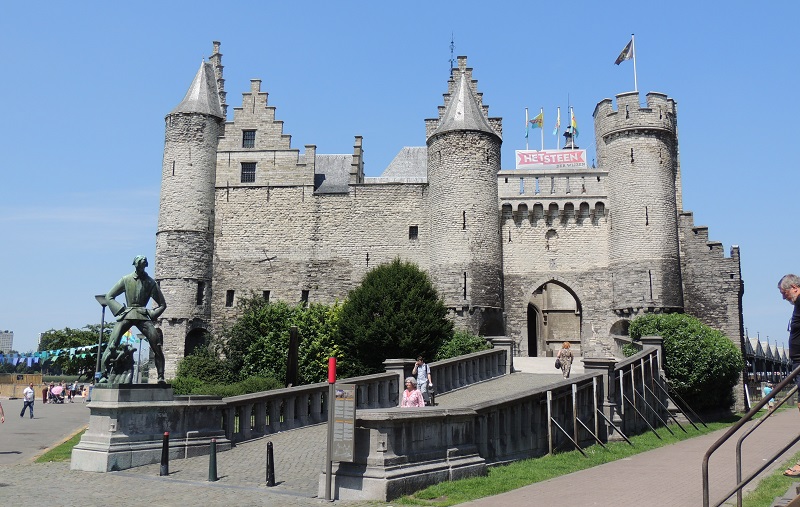
The castle Het Steen is Antwerp’s oldest building. It was built between 1200 and 1225 and is located on the river Scheldt. With towers and spires, it is a real fairytale castle. Originally, Het Steen was known as Antwerpen Borg, but at the beginning of the 16th century it got its current name after a major reconstruction.
In the period 1303-1827, parts of Het Steen were used as a prison. From 1952, the National Maritime Museum/Nationaal Scheepvaartmuseum was located here, and today the castle is used for exhibition purposes, and there is also a café here. There are many interesting boats around the castle, and you can also take a trip along the raised promenade along the Schelde from Het Steen.
Antwerp’s Gothic Cathedral of Our Lady was initially built 1351-1521, and despite large-scale extension plans, it has never been completed. The clearest example of this is that only one of the two planned towers has been built. The tower measures 123 meters in height and is the most significant building in Antwerp’s skyline.
In the cathedral you can see paintings by various artists, not least three works by Rubens, but also by, among others, Otto van Veen and Marten de Vos.
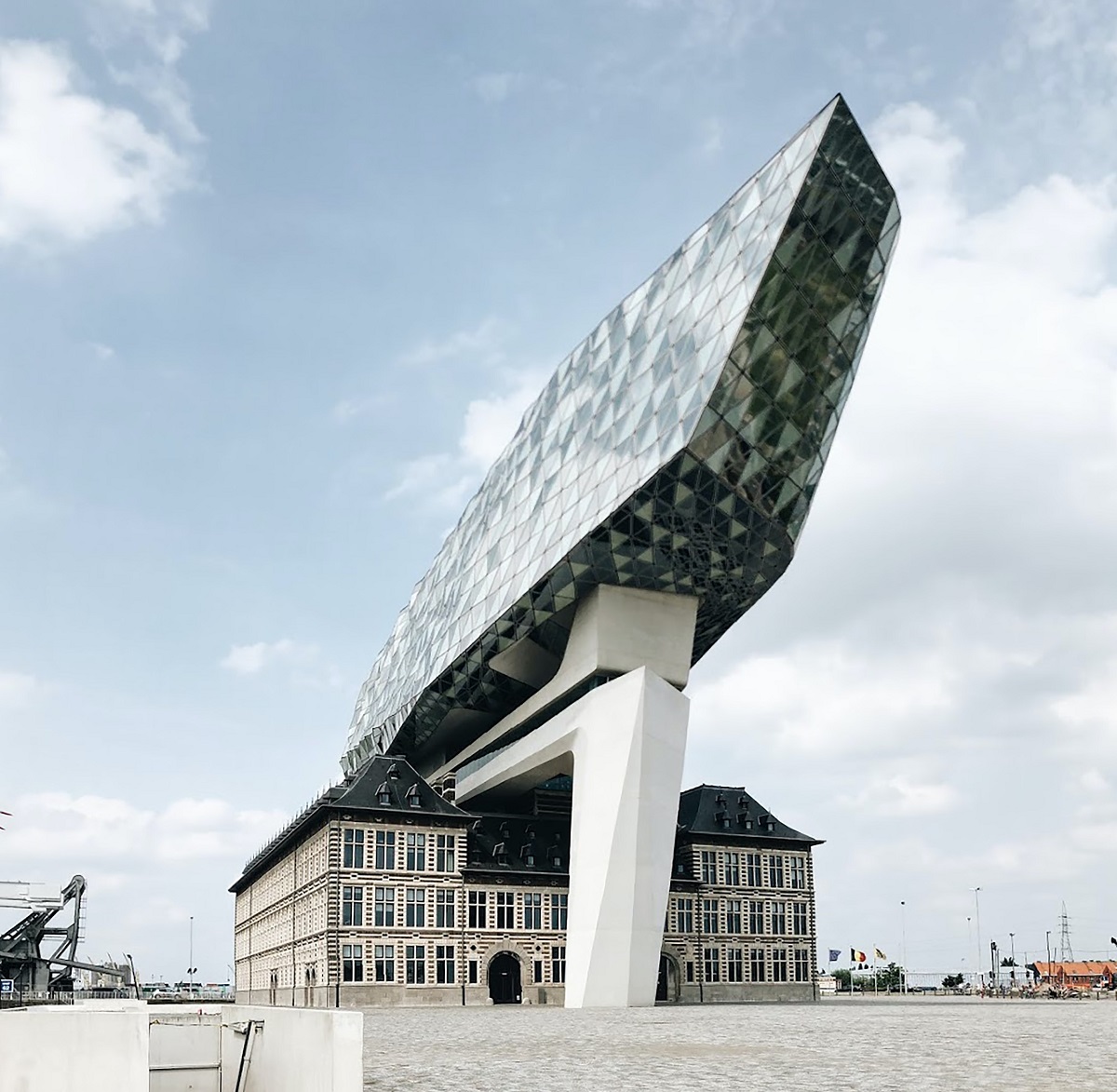
This interesting building combines new and old in interesting architecture and stands as one of Antwerp’s modern landmarks. The building complex lies down to the river and is the headquarters of Antwerp’s port authorities.
The Havenhuis itself is a new building that was built 2009-2016 according to a design by Zaha Hadid on top of a former fire station. The two buildings form an exciting whole, where shapes and appearance change depending on the angle from which Havenhuis is viewed.
Sint-Jacobskerk is the place where Antwerp’s world-famous city boy Pieter Paul Rubens is buried. His grave is behind the main altar in Vor Frue Kapel/Onze Lieve Vrouwekapel. The painting of Our Lady was painted by Rubens for this very occasion.
The church itself is impressive. It was built 1491-1656 in a district that was characterized by great prosperity with many well-to-do merchants and part of the aristocracy. Therefore, the church’s tower had to be the city’s tallest, which also meant higher than the cathedral’s. However, the building had to be abandoned at a height of 55 meters due to a lack of money, but what remains is the very solid foundation for an intended high spire.
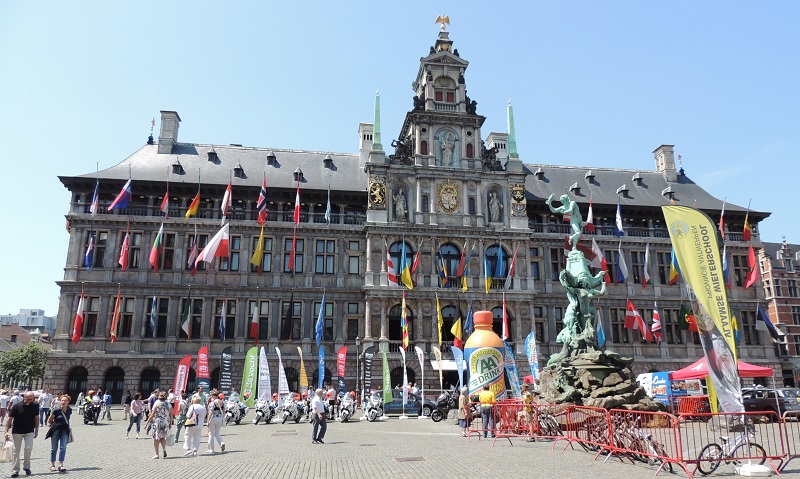
Antwerp’s beautiful city hall was built in the Flemish and Italian Renaissance in the years 1561-1565. On the richly ornamented central part of the building, you can see a sculpture of the Virgin Mary and two that symbolize wisdom and justice.
There are also three coats of arms for the region of Brabant, the Spanish Habsburgs and Antwerp respectively; seen from the left. Inside the building you can see a number of beautiful halls, and in the Leyszaal hang portraits of the Dukes of Brabant.
The Antwerp Commodity Exchange is called the mother of all stock exchanges, and the original building was built in 1531 as a replacement for the small and 16-year-old Gamle Børs/Oude Beurs. The current Handelsbeurs in late Gothic style dates from 1872. The previous building burned down in 1858.
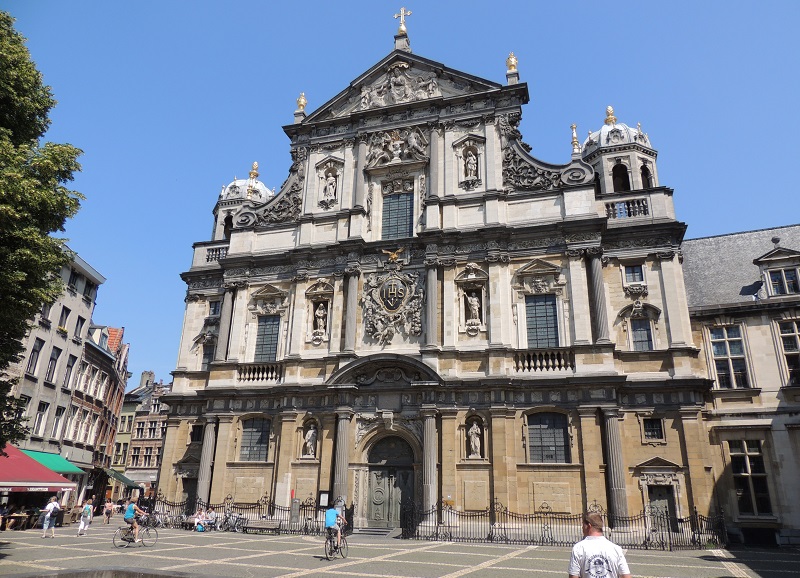
Carolus Borromeuskerk is a former Jesuit church that was built in period Baroque 1615-1621. The inspiration comes from the main church of the Jesuits; Gesu Church in Rome.
Peter Paul Rubens participated in the decoration of both the facade and the interior through both his own works of art and the works of his students, who included Anthony van Dyck and others. However, much was destroyed by a fire in 1718, which destroyed Rubens’ 39 ceiling paintings, among other things.
Rockoxhuis is named after its resident in the 17th century, Nicolaas Rockox, who was mayor of Antwerp. Rockox was also a friend of Rubens and an avid art collector. In the Rockoxhuis, today you can see a distinguished art collection with works by, among others, Rubens, Van Dyck and Breughel.
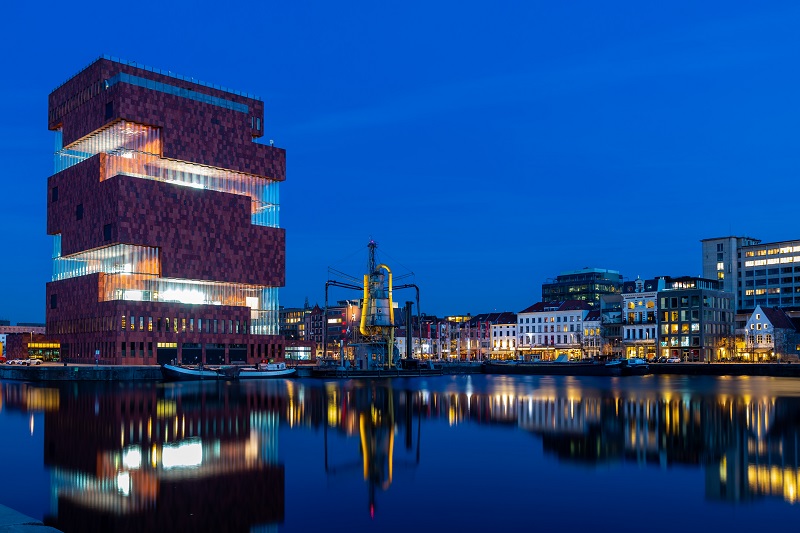
This museum opened in 2011 and is housed in one of Antwerp’s characteristic newer buildings. It is 60 meters high and has a mixed stone and glass facade. At the Museum aan de Stroom you can see an overwhelming collection of effects that are concentrated around the city, energy, life and Antwerp’s long history as a port city.
The museum building itself is located at the innermost part of the city’s huge harbor areas, which are among Europe’s largest. The basin to the west of the museum is the Bonapartedok, which is connected to the River Schelde via the Bonaparte Sluis. To the east is Willemdok. Both docks are from the first half of the 19th century; Bonapartedok is named after Napoleon, who started the construction of the dock in 1811.
Vleeshuis is Antwerp’s former slaughterhouse and meat market. The building was built in late Gothic style in the years 1501-1504. Today, the house is set up as a museum where the local history is documented. Archaeological finds are shown here, and some of the city’s traditions in, among other things, ceramics and glass art are exhibited.
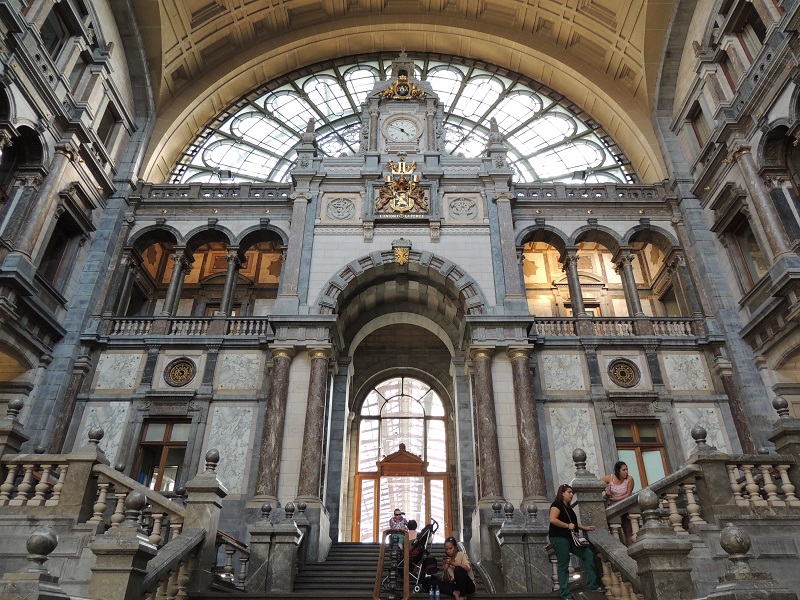
Antwerp’s palatial main railway station was built between 1895 and 1905 and is considered to be Belgium’s most beautiful railway construction. Not only the building’s many details in the decoration, but also the size is impressive. The station is 186×66 meters in ground plan with a height that reaches 43 meters.
The railway station was built as a replacement for the first terminus on the Brussels-Mechelen-Antwerp railway, which opened in 1836. The most significant expansion since the opening in 1905 is the high-speed tracks, which lie in a tunnel under the city and thus also Antwerp-Centraal. They opened in 2007.
Ever since 1661, there have been opera performances in Antwerp. First it took place in a theater on the Grote Markt and later in other theaters such as Bourla Theatre.
The current neo-baroque opera house was built 1904-1909; however, the inauguration took place already in 1907. In the beginning, the performances were Flemish/Dutch, but after a merger with the French/Italian operas in 1981, a varied range of performances is now staged in several languages.
The world-famous artist Peter Paul Rubens is known as one of the great painters of the Baroque. On a visit here to his palace-like home, you can of course see examples of it, but you get a very nuanced picture of Rubens above through an exhibition of him as an architect, diplomat, scientist and other of the works he spent his time on.
Rubens lived in the house in the period 1611-1640. The city of Antwerp bought the site in 1937 and it then underwent a major renovation in order to be as well preserved as possible.
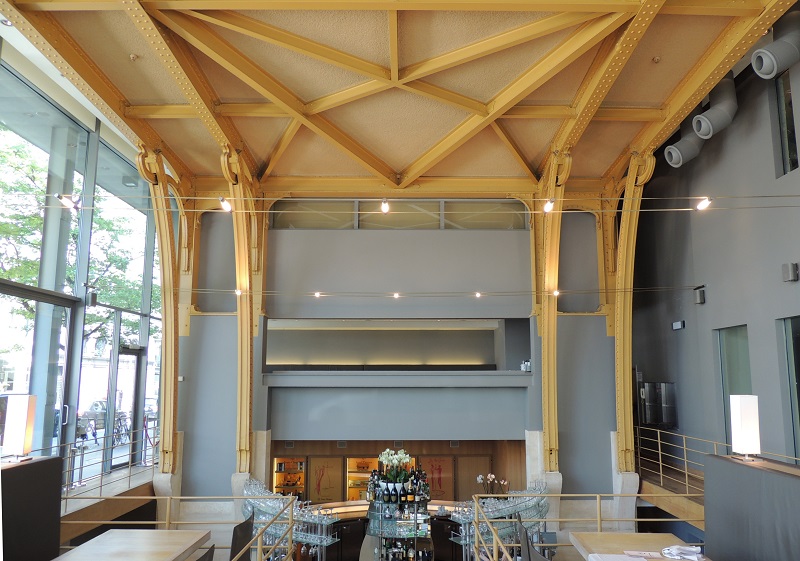
Grand Café Horta is a café that is furnished in a setting that was partly created from the creations of the architect Victor Horta. Victor Horta designed the world’s first house in the art nouveau style, and his work can be seen in several places in the streets of Brussels. His greatest work was the People’s House/Volkshuis/Maison du Peuple in the street Joseph Stevensstraat.
The Volkshuis was inaugurated in 1899 and demolished in 1965. In order to rebuild the architectural gem, the house was dismantled and put into storage in the town of Tervuren, but it was never rebuilt.
In the 1980s, there were plans in the district of Jette to build a Hortapavillon from the parts from the Volkshuis, but only a few parts were laid out in the landscape, and other parts perished before the project was abandoned.
In 1988, the remaining parts came to Ghent, but the Hortapavillon was not built here either. Instead, the parts came to Antwerp, where a competition was launched to reuse the parts in a new building. The Palm brewery won with their Grand Café Horta, which was inaugurated in the year 2000.
At this royal art museum, you can see a string of paintings, sculptures and drawings from the 15th and 19th centuries. The collection is particularly concentrated on artists from Antwerp, Belgium and the Netherlands.
The museum building was built in neoclassicism 1884-1890, and in the galleries you can see works by artists such as van Eyck, Frans Hals, Rubens, Brueghel and Auguste Rodin.
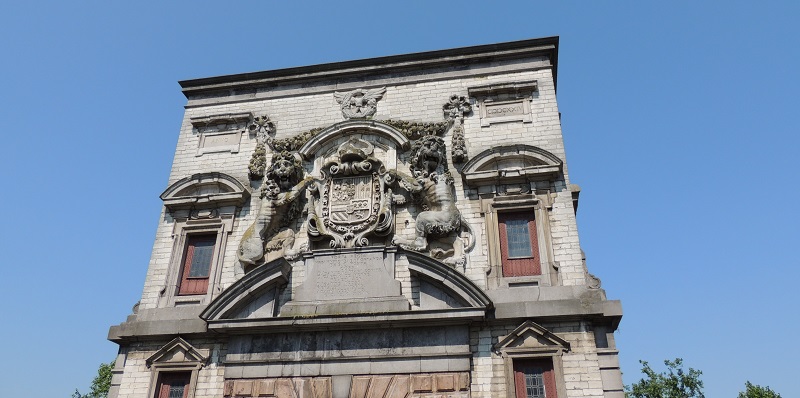
Waterpoort was one of Antwerp’s city gates and, as the name suggests, this led to the river Scheldt. The gate was built in 1624 as a triumphal arch for King Philip IV. It originally stood on the Vlasmarkt, but was moved to a new location in 1880, only to be moved again in 1933. Three years later, the gate was rebuilt in its current location.
From several boulevards you can see the Palace of Justice’s characteristic roof, which makes the building one of the most striking of the city’s recent architectural constructions.
Behind the drawings is Richard Rogers, who, among other things, also drew the Millennium Dome in London. The shape seen from above is a house with six wings, which is why it is also called the Butterfly Palace/Vlinderpaleis.
On top of the individual courtrooms in the building are the pointed roof hats. In total there are 6 large and 26 smaller of these. The Palace of Justice was inaugurated on 28 March 2006 with the participation of King Albert of Belgium.
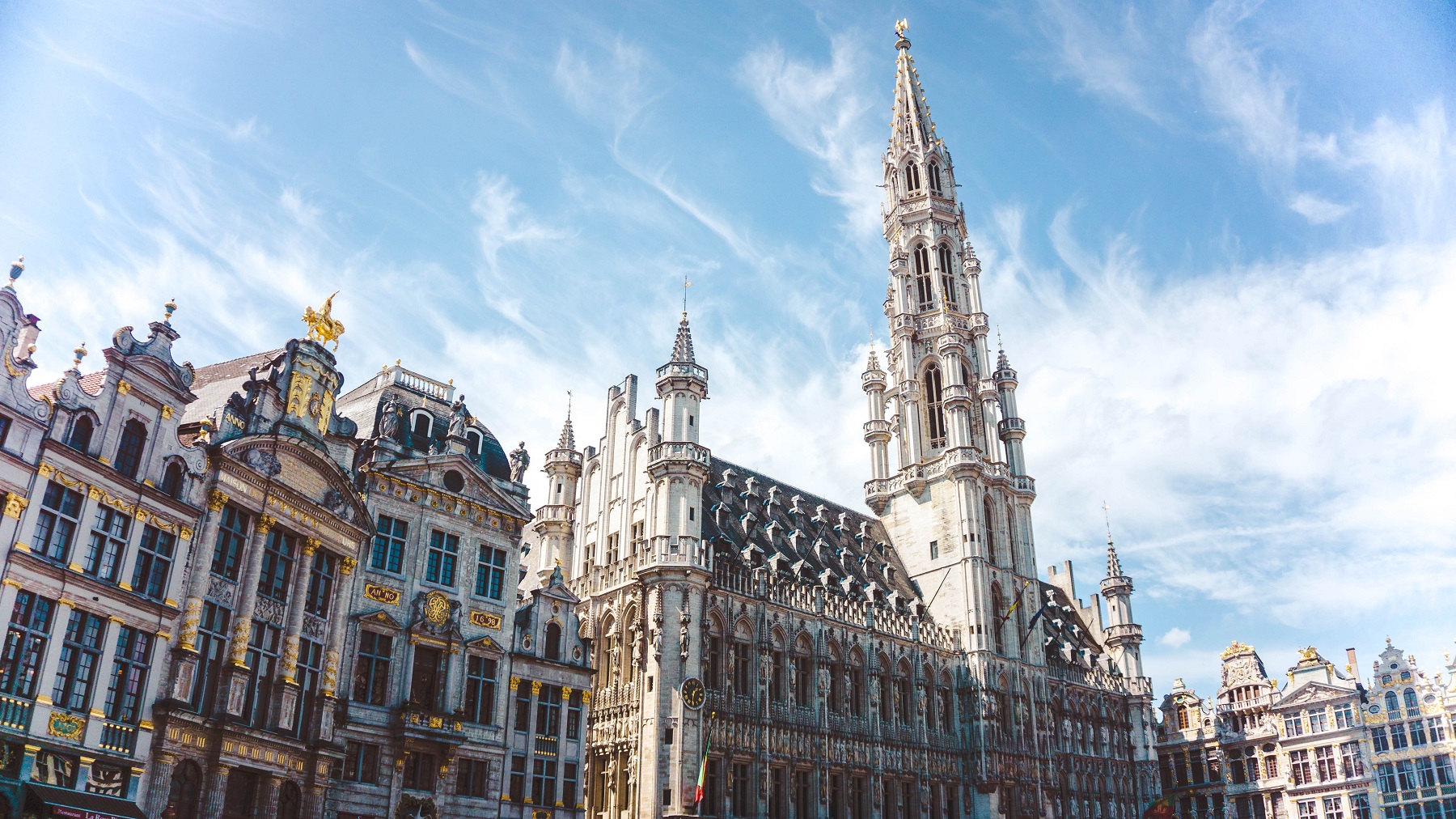
Brussels is home to the European Parliament, for many, one of the symbols of the European Union, but the Belgian capital has so much else to offer from its long Flemish history. The city center is Grote Markt / Grand Place, which is considered one of the most beautiful squares in the world.
Only a few minutes walk from Grote Markt, you can see the figure Manneken Pis, the boy who continues to pee after many centuries. And in the old town center there are numerous sights in an easy walking distance from one place to another. Manneken Pis is by the way seen seasonally with different clothes and he always draws many tourists.
A little south of Antwerp’s central ring road is the Middelheim Museum, a beautiful sculpture park built around the small castle Middelheim. More than 300 sculptures are set up in the large park area, and you can follow them in chronological order starting with Auguste Rodin. Many artists are represented; among them is Henry Moore.

Leuven is one of the well-known Flemish cultural cities in Belgium. The city is known to be mentioned for the first time in 891 in connection with the Battle of Leuven. Over the following centuries, the city developed into one of the most important trading cities in the Duchy of Brabrant, which was a state in the Holy Roman Empire.
There was also a large textile production in the 1400s and 1500s, and the 15th century became a golden age for the city with the foundation of the university in 1425 and the construction of large buildings such as Leuven’s town hall. The city continued as a center of knowledge, and Erasmus and Gemma Frisius worked here. Throughout the 1700s and 1800s, Leuven was rapidly developed, and the industry developed with Den Horn brewery and others.
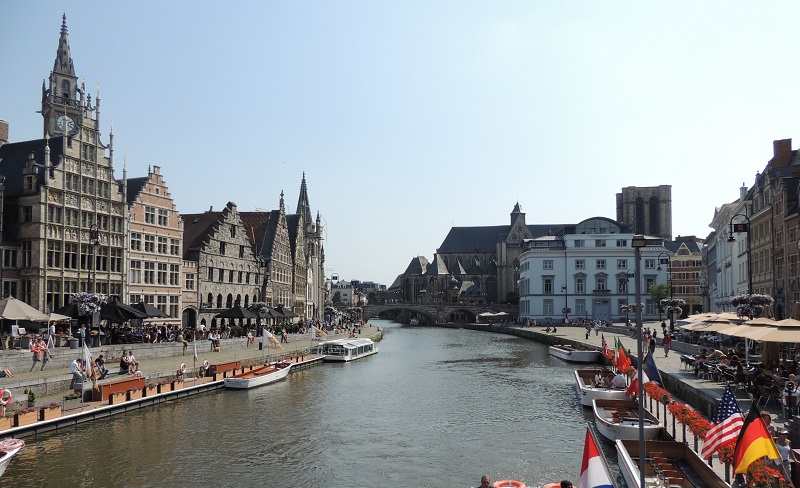
Ghent is a city with a past as one of Europe’s largest cities. It was once the center of Europe’s wool and textile trade, and there was a strong urbanization and industrialization early on. Together with the success of the merchants, it created tremendous wealth, which resulted in, for example, many of the beautiful buildings visitors can see in the city center today.
Cathedrals, churches, monasteries, squares, merchant residences and museums are located in large numbers between the canals in the old town which have retained its medieval character. The large buildings stands next to each other, and the city center is laid out nicely as a continuous open urban space.

Bruges is one of Europe’s old and rich trading centers, where the fine history of merchants and shipping has created a tourist gem in western Flanders. Here, Flemish urbanization has, over time, gone hand in hand with cultural and economic progress, and the result is so picturesque and interesting with loads of beautiful buildings.
The city’s central squares with Markt and Burg at the forefront are great places to enjoy the the spirit of centuries of architecture. Churches are located at the squares, where the town hall and other famous buildings have been built on the profits of the trade.

Rotterdam is the second largest city in the Netherlands, and it is known for several things; not least for a glorious maritime history and Europe’s largest port. The area has been developed from the city center and all the way to the mouth of the Nieuwe Maas in the North Sea west of the city.
The maritime experiences make their mark on the city, which offers many lovely places along the water and around old port facilities. In addition, there are some excellent maritime museums and of course the opportunity to take a cruise on the harbor with one of the city’s many cruise boats.
Keyserlei 58
centurycenter.be
Appelmans Straat
Beddenstraat 2
grandbazarantwerp.be
Meir 78/Hopland 31
stadsfeestzaal.com
De Wilde Zee, Meir and side streets, Keyserlei and side streets, Leopoldstraat, Chinatown, around Centraal Station, Eiermarkt / Melkmarkt / Korte Koepoortstraat, Lange Koepoortstraat, Klapdorp, Paardenmarkt
Piraten Eiland
Kribbestraat 12
pirateneiland.be
Zoo Antwerpen
Koningin Astridplein 26
zooantwerpen.be
The history of the city of Antwerp dates back to the 100-200 figures of the Gallic-Roman era, which shows various finds from excavations. In the beginning there were two settlements, Aanwerp and Caloes, which gradually grew together.
In the 600s, the city was fortified and around the same time Amand Christianized the area. Normans ravaged the city in the 8th century and the castle was destroyed on that occasion.
Following the Treaties of Verdun (843) and Mersen (870), Antwerp became the border town of the German-Roman Empire, and the city was once again fortified, this time with the precursor of Het Steen, which can be seen by the river Schelde today.
The river formed the border between Flanders on the western side and Brabant on the eastern side of Antwerp. Churches and monasteries were erected and the city grew. The street network today shows the growth that took place in concentric circles.
Economic boom
In the first half of the 1300s, considerable economic growth occurred in Antwerp, which at that time was among Western Europe’s leading cities. This was not least due to the large port that made Antwerp the entire financial and commercial center of the region.
In 1356, Antwerp became part of Flanders, and thus the city lost status to Bruges, the capital. After half a century, growth and the status of the city returned. Now Antwerp’s golden age had begun, and the city was one of the world’s absolute centers of both commerce and culture. The time was also when the Flemish painters came forward.
In the early 1500s, commercial houses were moved from Bruges to Antwerp and one of the important products was sugar. Raw materials were imported and refined in the city by not least Italians and Germans, who exported the finished sugar to Cologne, for example. Several other commodities were also traded and an actual exchange was established.
Antwerp accounted for about 40% of world trade, and the city was the richest in Europe. Several economic boom came during this time, marking Antwerp’s golden age. The main items were pepper, American silver and textiles, all of which created great wealth.
At the end of the 16th century, it went the opposite way, not least because of religious, political tensions between the Protestant Netherlands to the north and Catholic Spain that prevailed at this time. After several settlements, Antwerp finally fell in 1585, and then the northern Netherlands closed the traffic on Schelde.
Financially, it was a setback for the city, and beyond that, many intellectuals moved to other places where they could live with their Protestant faith.
Despite the harsh economic conditions, there was a continued flourishing cultural life in Antwerp through the 1600s, which brought to light, among others, the painters Rubens and Van Dyck.
From the end of the 17th century and the following centuries, the city was continually reduced to an actual provincial town. From more than 100,000 inhabitants in the 16th century, the population of about 50,000 declined and stagnated until around 1800.
It was not least the prolonged closure of the river that undermined the possible economic development. In terms of the treaty, the closure had been manifested with the Peace of Münster in 1648.
Both during the Austrian Habsburgs (1715-1792) and during France (1792-1815) the river was sought to be opened to traffic, and when the French succeeded in this venture, they were merely met by an English blockade during the Napoleonic wars.
After the peace settlement in 1815, the Netherlands were reunited and Antwerp could again flourish in an open economy. Some new docks were brought; for example, the central Napoleonic dock that strengthened the city’s economy.
By the Belgian Revolution of 1830 Schelde was again closed, but this time only until 1863, and since then it has been open. The river and river traffic brought an ever-increasing prosperity to Antwerp, whose port today is also one of Europe’s largest.
The young Belgian nation depended on Antwerp’s economy, and through the 19th century a defense ring with advanced forts was built about ten kilometers from the city; these can still be seen today.
The economy was booming and, with it as a focal point, the city’s ability to be shown to the world at the Exposition Internationale d’Anvers World Exhibition, conducted with more than three million visitors on 5 May-5. November 1894.
The port of Antwerp has continued to grow, and the freight volumes here have the advantage of being able to move by road or rail from a central location in the heart of Europe.
Culturally, the city has also come a long way. The first gymnastics world championships took place here in 1903, the Olympic Games were held here in 1920, and in 1993 Antwerp was the European Capital of Culture to name a few examples.
The two world wars of the 20th century also marked the city, which in both cases was occupied by German troops. During World War II, the city’s major port was strategically important, and from May 1940 to September 1944, Germany controlled Antwerp. From there and the rest of the war the port was tried to be bombed by the Germans. V2 bombs dropped in large numbers over the area, where the city itself was partially destroyed.
A large-scale and modern reconstruction took place and, in recent years, parts of the city have undergone a new revitalization. Among other things, this has happened in the district of Zuid, where modern buildings and urban planning are at the forefront.
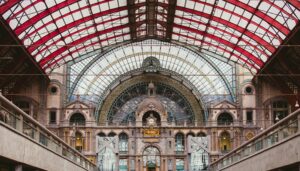 Antwerp Central Station[/caption]
Antwerp Central Station[/caption]
Overview of Antwerp
Antwerp is a Flemish metropolis that has become rich after centuries of large-scale trade with the whole world, and it can still be seen today with the city’s activity and busy port. With Antwerp’s strategically good location, it has developed into one of Europe’s largest port citys.
The city center is beautiful and characterized by the wealth that through time made the city’s commercial and religious buildings possible to build. Many areas have richly furnished houses with Grote Markt as the central square. When in town, it is just about exploring central Antwerp and enjoy the fine architecture and atmosphere here.
Churches and buildings have been built over time in varying architectural styles in the city. The highlights of Antwerp’s many large churches are for many the works of art created by not least Peter Paul Rubens. From the old beautiful architecture to today’s modern architecture, the city is visibly evolving. This can be seen in some of the areas down to the river Schelde, and there are also recently developed areas along the old harbor basins closest to the center.
About the Whitehorse travel guide
Contents: Tours in the city + tours in the surrounding area
Published: Released soon
Author: Stig Albeck
Publisher: Vamados.com
Language: English
About the travel guide
The Whitehorse travel guide gives you an overview of the sights and activities of the Canadian city. Read about top sights and other sights, and get a tour guide with tour suggestions and detailed descriptions of all the city’s most important churches, monuments, mansions, museums, etc.
Whitehorse is waiting for you, and at vamados.com you can also find cheap flights and great deals on hotels for your trip. You just select your travel dates and then you get flight and accommodation suggestions in and around the city.
Read more about Whitehorse and Canada
Canada Travel Guide: https://vamados.com/canada
City tourism: https://visitwhite-horse.ca
Main Page: https://www.vamados.com/
Buy the travel guide
Click the “Add to Cart” button to purchase the travel guide. After that you will come to the payment, where you enter the purchase and payment information. Upon payment of the travel guide, you will immediately receive a receipt with a link to download your purchase. You can download the travel guide immediately or use the download link in the email later.
Use the travel guide
When you buy the travel guide to Whitehorse you get the book online so you can have it on your phone, tablet or computer – and of course you can choose to print it. Use the maps and tour suggestions and you will have a good and content-rich journey.


Antwerp’s beautiful city hall was built in the Flemish and Italian Renaissance in the years 1561-1565. On the richly ornamented central part of the building, you can see a sculpture of the Virgin Mary and two that symbolize wisdom and justice.
There are also three coats of arms for the region of Brabant, the Spanish Habsburgs and Antwerp respectively; seen from the left. Inside the building you can see a number of beautiful halls, and in the Leyszaal hang portraits of the Dukes of Brabant.
The Antwerp Commodity Exchange is called the mother of all stock exchanges, and the original building was built in 1531 as a replacement for the small and 16-year-old Gamle Børs/Oude Beurs. The current Handelsbeurs in late Gothic style dates from 1872. The previous building burned down in 1858.

Carolus Borromeuskerk is a former Jesuit church that was built in period Baroque 1615-1621. The inspiration comes from the main church of the Jesuits; Gesu Church in Rome.
Peter Paul Rubens participated in the decoration of both the facade and the interior through both his own works of art and the works of his students, who included Anthony van Dyck and others. However, much was destroyed by a fire in 1718, which destroyed Rubens’ 39 ceiling paintings, among other things.
Rockoxhuis is named after its resident in the 17th century, Nicolaas Rockox, who was mayor of Antwerp. Rockox was also a friend of Rubens and an avid art collector. In the Rockoxhuis, today you can see a distinguished art collection with works by, among others, Rubens, Van Dyck and Breughel.

This museum opened in 2011 and is housed in one of Antwerp’s characteristic newer buildings. It is 60 meters high and has a mixed stone and glass facade. At the Museum aan de Stroom you can see an overwhelming collection of effects that are concentrated around the city, energy, life and Antwerp’s long history as a port city.
The museum building itself is located at the innermost part of the city’s huge harbor areas, which are among Europe’s largest. The basin to the west of the museum is the Bonapartedok, which is connected to the River Schelde via the Bonaparte Sluis. To the east is Willemdok. Both docks are from the first half of the 19th century; Bonapartedok is named after Napoleon, who started the construction of the dock in 1811.
Vleeshuis is Antwerp’s former slaughterhouse and meat market. The building was built in late Gothic style in the years 1501-1504. Today, the house is set up as a museum where the local history is documented. Archaeological finds are shown here, and some of the city’s traditions in, among other things, ceramics and glass art are exhibited.

Antwerp’s palatial main railway station was built between 1895 and 1905 and is considered to be Belgium’s most beautiful railway construction. Not only the building’s many details in the decoration, but also the size is impressive. The station is 186×66 meters in ground plan with a height that reaches 43 meters.
The railway station was built as a replacement for the first terminus on the Brussels-Mechelen-Antwerp railway, which opened in 1836. The most significant expansion since the opening in 1905 is the high-speed tracks, which lie in a tunnel under the city and thus also Antwerp-Centraal. They opened in 2007.
Ever since 1661, there have been opera performances in Antwerp. First it took place in a theater on the Grote Markt and later in other theaters such as Bourla Theatre.
The current neo-baroque opera house was built 1904-1909; however, the inauguration took place already in 1907. In the beginning, the performances were Flemish/Dutch, but after a merger with the French/Italian operas in 1981, a varied range of performances is now staged in several languages.
The world-famous artist Peter Paul Rubens is known as one of the great painters of the Baroque. On a visit here to his palace-like home, you can of course see examples of it, but you get a very nuanced picture of Rubens above through an exhibition of him as an architect, diplomat, scientist and other of the works he spent his time on.
Rubens lived in the house in the period 1611-1640. The city of Antwerp bought the site in 1937 and it then underwent a major renovation in order to be as well preserved as possible.

Grand Café Horta is a café that is furnished in a setting that was partly created from the creations of the architect Victor Horta. Victor Horta designed the world’s first house in the art nouveau style, and his work can be seen in several places in the streets of Brussels. His greatest work was the People’s House/Volkshuis/Maison du Peuple in the street Joseph Stevensstraat.
The Volkshuis was inaugurated in 1899 and demolished in 1965. In order to rebuild the architectural gem, the house was dismantled and put into storage in the town of Tervuren, but it was never rebuilt.
In the 1980s, there were plans in the district of Jette to build a Hortapavillon from the parts from the Volkshuis, but only a few parts were laid out in the landscape, and other parts perished before the project was abandoned.
In 1988, the remaining parts came to Ghent, but the Hortapavillon was not built here either. Instead, the parts came to Antwerp, where a competition was launched to reuse the parts in a new building. The Palm brewery won with their Grand Café Horta, which was inaugurated in the year 2000.
At this royal art museum, you can see a string of paintings, sculptures and drawings from the 15th and 19th centuries. The collection is particularly concentrated on artists from Antwerp, Belgium and the Netherlands.
The museum building was built in neoclassicism 1884-1890, and in the galleries you can see works by artists such as van Eyck, Frans Hals, Rubens, Brueghel and Auguste Rodin.

Waterpoort was one of Antwerp’s city gates and, as the name suggests, this led to the river Scheldt. The gate was built in 1624 as a triumphal arch for King Philip IV. It originally stood on the Vlasmarkt, but was moved to a new location in 1880, only to be moved again in 1933. Three years later, the gate was rebuilt in its current location.
From several boulevards you can see the Palace of Justice’s characteristic roof, which makes the building one of the most striking of the city’s recent architectural constructions.
Behind the drawings is Richard Rogers, who, among other things, also drew the Millennium Dome in London. The shape seen from above is a house with six wings, which is why it is also called the Butterfly Palace/Vlinderpaleis.
On top of the individual courtrooms in the building are the pointed roof hats. In total there are 6 large and 26 smaller of these. The Palace of Justice was inaugurated on 28 March 2006 with the participation of King Albert of Belgium.
Similar to Antwerp Travel Guide
